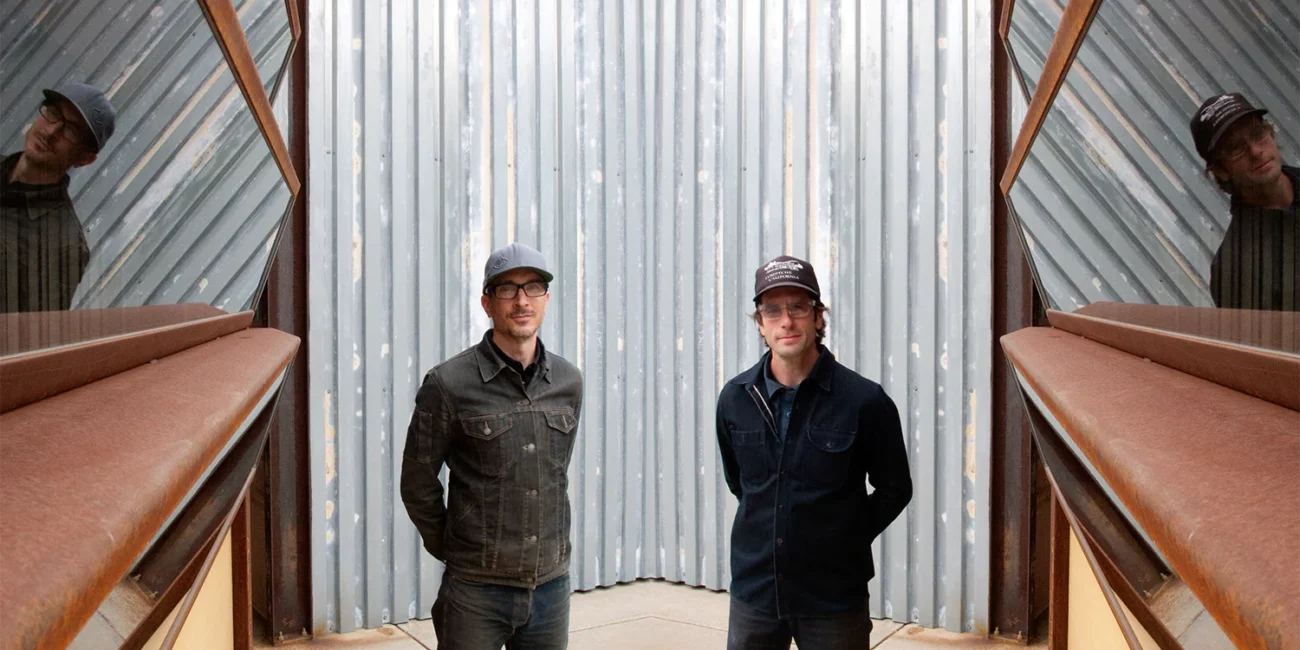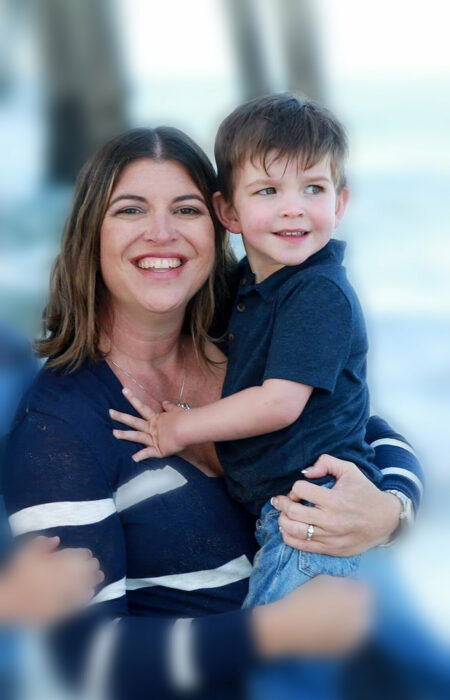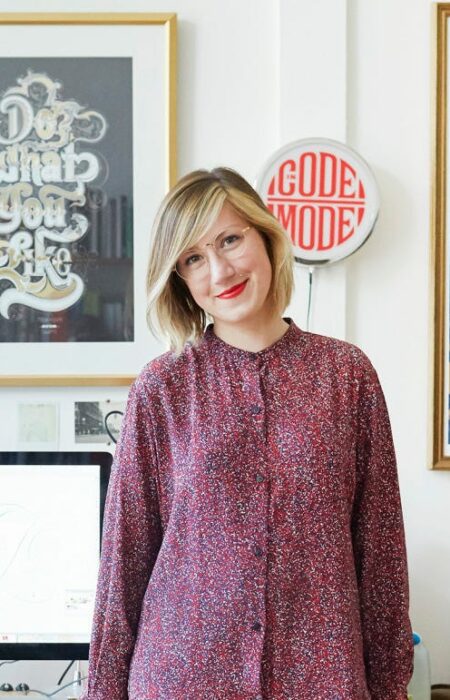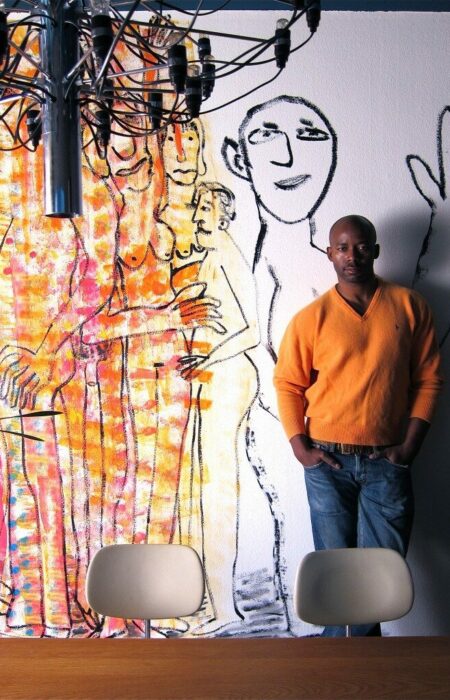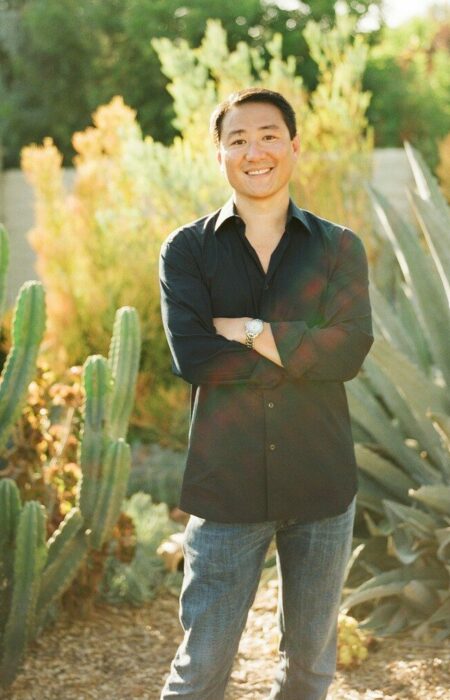David Larabee and Dexter Thornton are the furniture design and manufacturing duo of Denver-based DoubleButter. Influenced by mid-century modern design, their pieces are an inspired blend of American black walnut or forming plywood with metal in an array of creamy colors and interchangeable hides. Their penchant for taking the piss out of anyone belies a more serious devotion to craftsmanship and support of local artisans. David and Dexter, along with their band of creative misfits, speak a modern language of collaborative design, mischievous promotion, and thoughtful consumption that just might — pardon me, guys — change our culture.
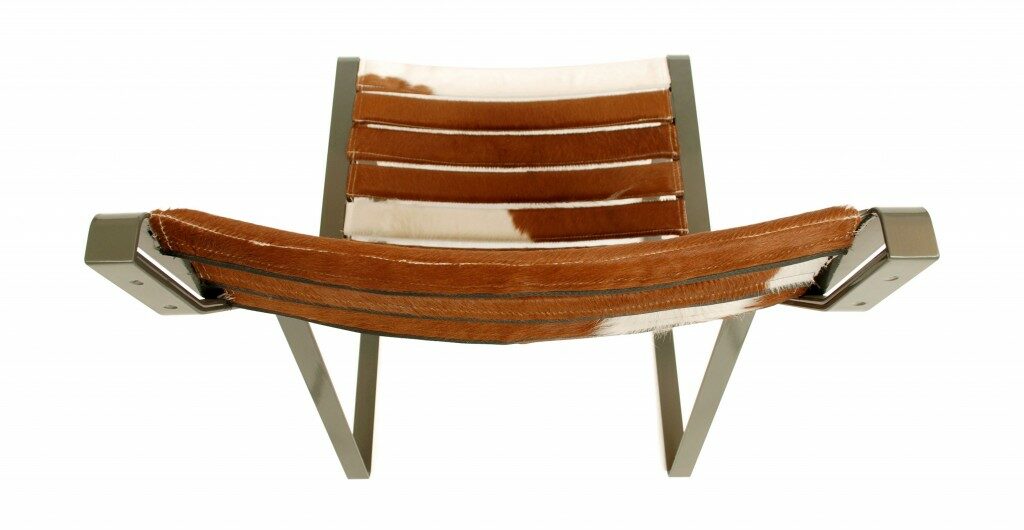
Grasshopper lounge by DoubleButter
I hear the name DoubleButter came from the imagined culinary effect of peanut butter and butter on each other. So I’m guessing no focus groups are involved in any of your creative decisions?
“Imagined” culinary effect? Hardly. It’s real — and if you doubt it, you should try it. Start with an English muffin, toast it, apply a bit of sweet cream butter and then a bit of peanut butter. You’ll see what we mean when we say that DoubleButter is better: the regular butter lubes up the sticky, pasty peanut butter, and the peanut butter gives the regular butter a little more spine.
And really, how many fools does it take to make a focus group? There are two of us, plus some others hanging around. Is that enough? How many butters do you need? You start to add too many, and you’re left with a brown goopy mess with none of the character of the original ingredients. Plus, aren’t focus groups full of idiots with nothing better to do?
Roadrunner chair by DoubleButter
I understand you each operated your own furniture business prior to coming together as DoubleButter. How did this idea to join forces come about, and what are some of the biggest positives of working as partners?
We did have our own companies before we hooked up, but they were hardly thriving businesses. They were alive, and we were selling pieces, but we were both casually looking for someone to help us expand and to bring in new skills and materials. David had a show set up at a local gallery (P Design Gallery, now defunct), and the idea of showing the same shit he’d been making for years in a new space made him very sleepy. Very, very sleepy. So instead we decided to give the collaboration thing a shot with that show — in which Paul Hardt, P Design’s owner, decided to pair us with Tord Boontje, for no good or apparent reason. The show was called DoubleButter Boontje — and if it didn’t work out, no harm, no foul. But it did work out. The pieces were fresh and new, and the response was very positive. And the fact of having a partner helps to encourage the good ideas and to kill the bad ones early. It also helps to work through the details of the how before you find yourselves cheek deep in a brown goopy mess. But mostly (forgive the cheese here) it encourages play and makes it very hard to get all puffed up taking yourself too seriously. You start getting puffy and serious, and the other jerk is going to stick a pin in you.
Elephant dining table by DoubleButter
SB3 sideboard by DoubleButter
Sheep dresser by DoubleButter
Can you tell me about your respective strengths in working with metal and wood, and how you collaborate to design and determine fabrication for new pieces?
Hmm. David’s background was mostly in wood and Dexter’s mostly in steel, but that was really a product of what tools we happened to acquire and master. Our interests were never so confined. Coming together as partners brought the tools together too. Plus, now that we’ve been at this for a few years, we’ve got access to light-industrial shops around town. Water-jet shops, steel fabrication shops, plastics shops, woodworking shops. All that factors into the design process. Since we are a design-build company, we don’t just drop a pretty rendering and a couple drawings on someone’s lap, telling them to figure out how to make it. We need to know how the thing will get made and know that it will do what it’s intended to do. And that’s where we start: with the intended use of the piece. Then we apply to that the processes and materials we know how to use, smearing on a little DoubleButter style to keep it in the language we’ve developed for our first line. The ideas all come out first on our assembly table with a sharpie, which gets handed back and forth, each of us adding and changing until we’re both more or less satisfied with what we’ve got.
Turtle dining table by DoubleButter
Close-up of Sheep dresser by DoubleButter
Surfboy bed by DoubleButter
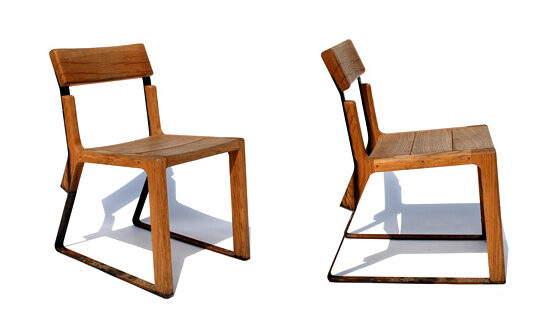
Peg Leg chair by DoubleButter
You’ve mentioned a kinship you feel with mid-century design. Who are some of your design heroes, what do you count as some of your biggest sources of inspiration, and how do you describe the DoubleButter language?
Well, we, like everyone who’s not a total jackass, love the Eamses. And we’re big fans of Jean Prouvé. And Poul Kjærholm. And the list goes on. But we like contemporary designers too. Like Piet Hein Eek and Nicola Staübli, and that list goes on and on too. But as far as inspiration goes, we spend a lot more time looking at the rest of the planet and the built world than we do looking at groovy furniture. Mostly we spend time in the shop and rolling on bicycles down the streets of the city. So we see the folded sheet metal and bent steel bases of our machinery and the machinery in the shops we visit. We see the clean exterior lines of much of the city’s better architecture. We look at the honest use of materials—steel, glass, concrete, wood—in the engineered world. That stuff makes a big impression on you when you start to notice it. And somewhere in that answer is a decent description of the DoubleButter language.
DoubleButter’s Fred Perry chair next to some design classics
EC3 entertainment credenza by DoubleButter
Armadillo coffee table by DoubleButter
Crane desk by DoubleButter
The colors you use in your metal pieces remind me of the soft colors of really cool vintage cars. How did you decide on a palette that worked well for you and suited both of your aesthetics?
It helps to have limits. Our powder coaters—the shop that applies the colored finish to our steel and aluminum parts—buy powder from two manufacturers. The colors we use come from one of the two: Tiger Drylac. So, when settling on colors, you’ve only got so many to choose from. We knew we didn’t want black and white (though those are the colors we used in our first show), since they’re lame. They’re the colors you pick when you can’t pick a color. From black and white we moved to cream or oyster white and a sort of traffic gray. Both are warmer and more organic and camouflage imperfections better than true black and white. And then we knew we wanted colors that we hadn’t seen on anyone else’s furniture, colors that were in a natural palette but weren’t pretending to be “moss” or “sky” — colors that complimented the walnut and forming plywood, weren’t too masculine or feminine. Oh, and we really wanted them to look good in Miami. That was very important.
Penguin side table by DoubleButter

Turtle dining table by DoubleButter
I love the hides that can be velcroed onto your metal chairs, benches and lounges. Can customers order sets of these to switch up the look of the piece they order?
Thanks, we love them too. The whole idea with the upholstery and the velcro system was interchangeability. You buy a chair, and, if you get sick of the look, you can swap out the upholstery for relatively little cost and you get essentially a new chair. Customers can call us and order new sets. And we do plan to introduce new options, we’re just not sure when. We have a sister company next door that makes padded instrument bags, and some of the sewers in that shop make the upholstery slats for us. We’d like to find other partners—auto upholsterers, clothing manufacturers, true furniture upholsterers—to develop new looks, increase the padding, cut down on costs. But we haven’t had much luck yet. Plus, we’d like to work with artists we know to develop limited edition sets of upholstered slats in the artists’ styles. We’ll get to that, we swear.
Close up of Grasshopper chair by DoubleButter
Crane stool by DoubleButter
Crane bench by DoubleButter
Roadrunner chair by DoubleButter
I see you also work with retailers and other businesses to come up with custom display systems. Tell me about this part of your business and where you see yourselves going with this.
We like the big projects now and again. Furniture pieces are fairly quick, and they get into a space and get lost in all the clutter. We’re biased, sure, but our pieces are almost always better than the spaces they occupy. It’s true. It’s sad to drop off a coffee table in front of an overstuffed doofus of a sofa or to drop a Roadrunner chair around some brainless dining table. Or worse still is when we deliver stuff to some sprawling suburban McMansion. We’re always tempted to turn the truck around, furniture still on board, and high-tail it out of there. By doing a bit of interior architecture we solve at least a piece of this, in our jaded little minds. We built out the interiors of a couple local retail shops: The 400 (a sneaker boutique) and DisRespectacles (an eyeglass boutique), both of which were on Platte Street in Denver. We also built out the displays and the furniture. So if the space doesn’t work—though both did work (we think)—it’s all on us. We’d like to do more of it, perhaps one day with our own retail spots of some variety.
DoubleButter’s display designs for The 400
Though you have a very laid-back, irreverent demeanor, there’s also a serious side to your mission of supporting local craftsmanship and encouraging people to opt for heirloom pieces. Do you have a sense of where we are as a culture in bringing back soul and artisanship in the things we create and buy?
We have no idea. We’re still a big-box, the-cheaper-the-better, McMansion, disposable society and culture, on a mass scale. Sure, there are real pockets of artisanal, craft-based, slow-food, bike-to-work, repair-it-don’t-chuck-it loonies out there, but they are no match for Walmart and American Furniture Warehouse. Plus, stores like DWR [Design Within Reach] really confuse people. The little designer photos and bios, the idea of celebrity design, the idea of curating your little collection of Famous Design — very attractive to many. But come on. Shouldn’t we all downsize just a bit? Stop buying stuff that should outlast us but that we’re gonna have to dump into a landfill too soon? Start supporting the fool down the street who makes the wicked fine bike frame or clothing or cheese or sculpture, even though our friends in New York have never heard of him. Denver — like L.A., or San Francisco, or Paris, or New York, or even Dubuque — has got its own culture worthy of support. If it gets support, it becomes a Place.
Edgar dresser by DoubleButter
Triple wide Crane bench by DoubleButter
Who is the Horsehead Crating crew, your ‘in-house strangeness group’?
Horsehead Crating Company is the brainchild of Darnell and Clovis Tillman. It started as a company that built shipping crates. We were referred to them by a guy in the neighborhood since we were tired of building our own, and they were purportedly fast, cheap, and, it turns out, out of control. When we were getting started on the new production line (and the website and graphic design and marketing that came with it), we were a little snowed under with all the work, so we asked them to help out where they could. Turns out they had more skill in photography and graphic design and interactive design than two assholes who build crates for a living should. So we hired them — we sort of bought their company, but they are now disputing that. Now they still build shipping crates for us and for others, but they also drive all of what passes for marketing around here. They make little videos, orchestrate street art stunts, generate content for our blog, build some of the lamer stuff interior designers ask us to build. But mostly they drink and play with fire.
The following video clip, set to a song called Prisencolinensinainciusol, shows DoubleButter and friends having fun road testing the Armadillo coffee table. The results: “If the table can handle a Molotov cocktail, we’re sure it can handle your wussy Mojito.”
You write a funny blog, document your ‘shoefiti’ sightings, and produce some offbeat videos that go a long way toward conveying the personality of DoubleButter. Is this just about having fun and letting off steam, or do you think consciously about this as a form of building your brand?
We really don’t have a whole lot to do with that, other than writing the words on the blog to go with the content that Darnell and Clovis and the rest of the Tillmans produce. We thought our brand would be cleaner and straighter, more like the rest of the site than like the Sandwich section. And as far as “conscious” thought goes, the Tillmans aren’t exactly known for that. Whatever personality or brand DoubleButter has is attributable to the Horsehead Crating crew’s desire to have a laugh, pure and simple. “Love and laughter, boys. That’s all there is.” We’re paying them, so the nonsense they get into has to at least peripherally relate to our furniture business, but it’s peripheral in the most generous sense. What do little rubber chairs thrown over wires in cities around the world have to do with anything, really?
Shoefiti that mimic the Roadrunner chair form
A shoefiti sighting in Denver, one of many around the world
Are you shipping your goods to any location?
We ship mostly to U.S. destinations (the site is set up for this and this alone), but we do occasionally ship overseas. Shipping is such a colossal pain in the ass, even with the Horsehead bozos handling it. And the rates are punitive unless you’re shipping tractor trailers full of stuff to a single destination. If it were up to us, and if it were enough to sustain us and the rest of the crew, we’d just deal with the Denver-Boulder area. Every city should have a DoubleButter equivalent, or several, and we should stop homogenizing the planet and re-develop a sense of local everywhere. But in the meantime, since we need to eat, we’ll ship our stuff anywhere anyone wants it.
For young creative people trying to get started in the midst of this challenging economy, what advice would you offer?
Learn a skill and master it. Seriously. Something you want to do as well or better than anyone. Make yourself into a great welder or seamstress or bass player or illustrator. The art side of it all will come or it won’t, you can’t really control that—but knowing the limits and the possibilities of the craft can only help. Spend the thousands of hours doing the thing you think you love doing, and become great at it. If you can’t put in the time, maybe you shouldn’t be doing it. And once you are a master, you’ll have work, either on your own projects or someone else’s. And if you’re good enough and for some reason you can’t make a go of it on your own, you’ll have your pick of where you want to work.
Grasshopper lounge chair by DoubleButter
Dexter welding, wearing his Ethan Hawke tribute gloves
What are you most proud of, and what do you love most about your work together?
Ask us that again when we’ve been at this a little longer. Right now we’d say everything. Just the fact that we set out to do this and we’re still at it, that we’re proud above all of the quality of the built pieces, and that the whole thing makes us laugh.
What are some of your favorite things, whether they impact your work directly or just make you happy?
Well, there are girls in white dresses with blue satin sashes, snowflakes that stay on our nose and eyelashes, silver white winters that melt into springs—these are a few of our favorite things. When the dog bites, when the bee stings, when we’re feeling sad, we simply remember our favorite things, and then we don’t feel so bad.
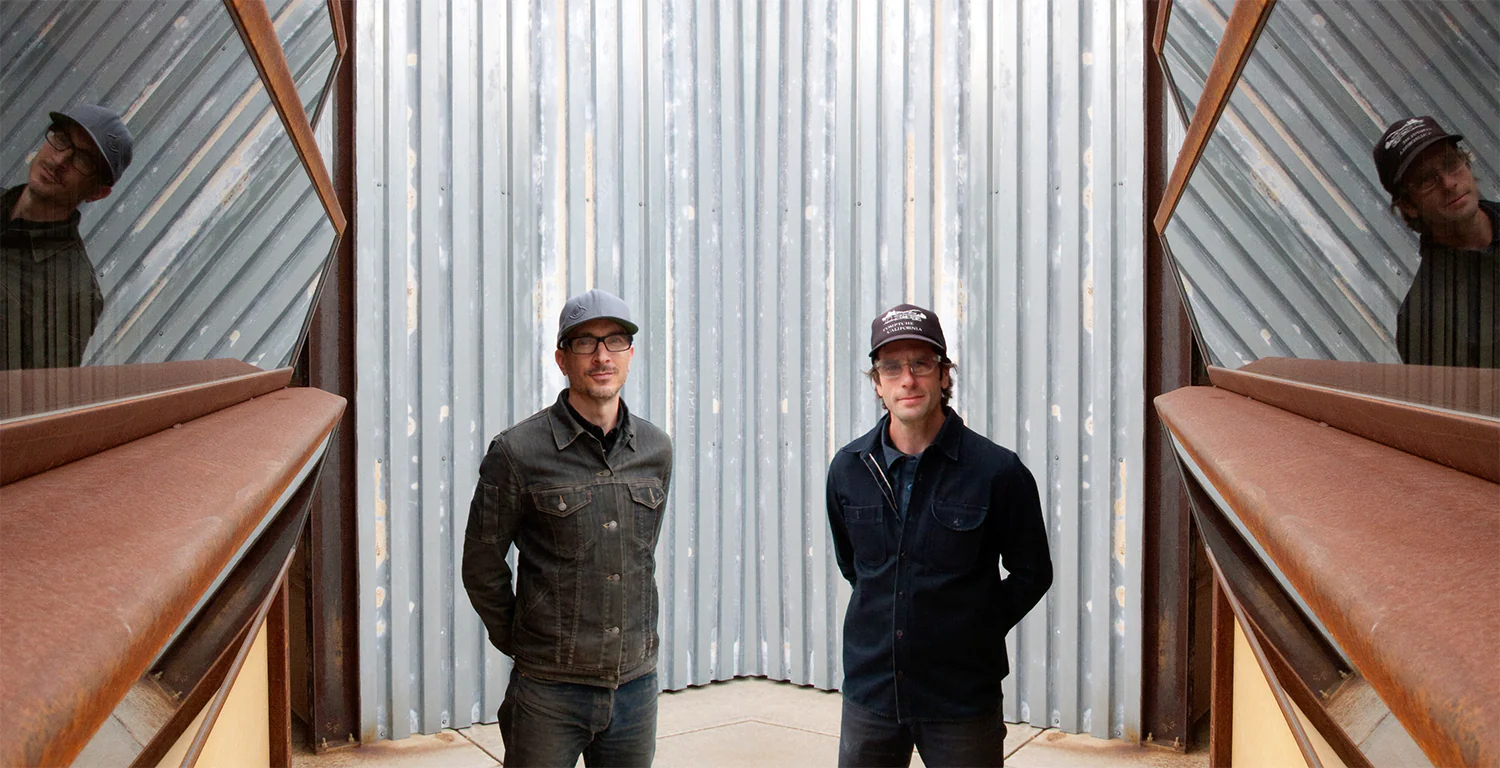
David Larabee and Dexter Thornton of DoubleButter
The above images include those from DoubleButter’s current product line, which ships within 10 days, as well as back catalog pieces that are made to order and ship within 8-10 weeks. Individual pieces showcased here may no longer be available but are included to convey the DoubleButter aesthetic and history. For details, visit their website.
Share the love, post a comment!

